Santos Bundle
How Does Santos Company Thrive in the Energy Sector?
Santos Company, a key player in Australia's energy landscape, recently reported impressive financial results, showcasing its robust Santos SWOT Analysis. With a net profit of US$1.2 billion and significant free cash flow, the company's financial health is undeniable. But how does this Australian oil and gas giant actually operate and generate its impressive revenue?
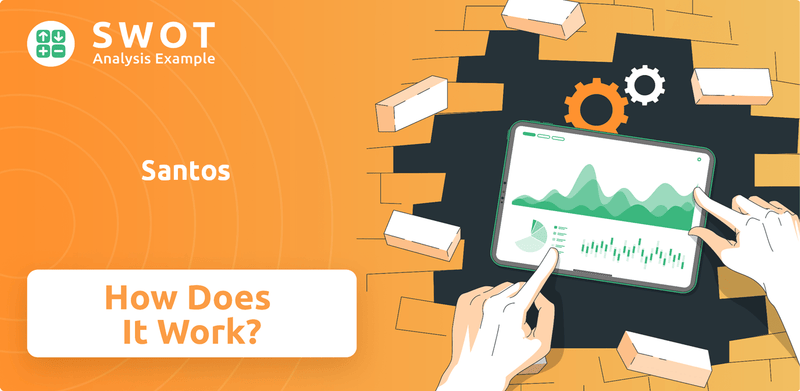
This exploration into the Santos business model will uncover the core of its operations, including Santos energy projects like Barossa and Pikka, which are crucial for future growth. We'll dissect how Santos Company navigates the complexities of the global energy market, focusing on its strategic moves and its commitment to sustainable practices. Understanding Santos operations is essential for anyone seeking to understand the dynamics of the oil and gas industry, and the potential for investments in Santos Australia.
What Are the Key Operations Driving Santos’s Success?
The core of the Santos Company lies in its integrated approach to the oil and gas sector. This involves the exploration, development, production, and marketing of its energy resources. The company's operations are centered around key products like natural gas, oil, LNG, ethane, methane, coal seam gas, and crude oil, catering to customers across Australia and Asia. Its operational processes encompass a robust supply chain, technological advancements, and efficient logistics.
The Santos business model is built on a foundation of disciplined cost management. This allows the company to maintain a competitive edge in unit production costs. This strategy enables the company to remain resilient throughout commodity price cycles. The company's focus on 'backfilling and sustainably growing' production around its existing LNG and liquids infrastructure leverages the long-term demand growth in the Asia-Pacific region. The company operates in key asset hubs including the Cooper Basin, Queensland and NSW, Papua New Guinea, Northern Australia and Timor-Leste, and Western Australia.
A significant component of the Santos Company's value proposition is its disciplined, low-cost operating model. This model aims to maintain a competitive advantage in unit production costs, allowing the company to thrive across commodity price cycles. This approach is essential for ensuring profitability and sustainability in the fluctuating energy market. The company's strategy focuses on 'backfilling and sustainably growing' production around its existing LNG and liquids infrastructure, leveraging long-term demand growth in the Asia-Pacific region.
The company's core offerings include natural gas, oil, LNG, ethane, methane, coal seam gas, and crude oil. These products are delivered to customers across Australia and Asia. The diverse product portfolio supports the company's revenue generation and market presence.
Santos operates in key asset hubs including the Cooper Basin, Queensland and NSW, Papua New Guinea, Northern Australia and Timor-Leste, and Western Australia. These hubs are critical to the company's production capacity. Strategic location enhances operational efficiency.
The company aims to maintain a competitive advantage in unit production costs. This allows the company to thrive across commodity price cycles. The focus is on 'backfilling and sustainably growing' production around its existing LNG and liquids infrastructure.
Santos enhances its operations through strategic partnerships and distribution networks. The company's partnerships support its expansion and efficiency. These networks are vital for market access and distribution.
The Barossa LNG project, which is 95.2% complete and on track for first gas in Q3 2025, and the Pikka phase one project in Alaska, 74% complete and on schedule for first oil in mid-2026, are examples of major developments. These projects will contribute to increased production and lower unit costs. The company is also investing in carbon capture and storage (CCS) technology.
- The PNG LNG project, in which Santos holds a 39.9% interest, has delivered over 83 million tonnes of LNG to Asian customers since 2014.
- The Moomba CCS project started up in late September 2024, aiming to provide low-cost, permanent carbon storage.
- The company continues to focus on sustainable growth and operational excellence.
- For more insights, consider reading about the Marketing Strategy of Santos.
Santos SWOT Analysis
- Complete SWOT Breakdown
- Fully Customizable
- Editable in Excel & Word
- Professional Formatting
- Investor-Ready Format
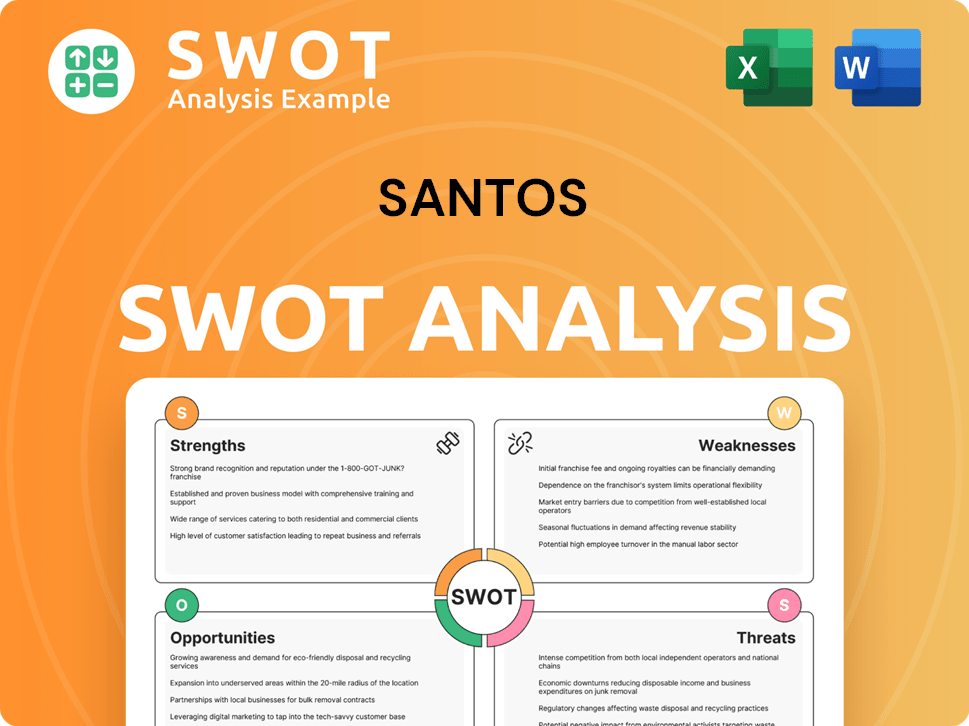
How Does Santos Make Money?
The core of the Santos Company's operations revolves around generating revenue from the sale of natural gas, oil, and liquefied natural gas (LNG). This is a key component of the Santos business model. The company strategically targets both domestic and international markets to maximize its sales potential.
For the full year 2024, the company reported robust sales revenue, reaching US$5.4 billion. This strong financial performance is further highlighted by a net profit after tax of US$1.2 billion and a free cash flow from operations of US$1.9 billion. This financial health underscores the effectiveness of its revenue generation strategies within the Santos energy sector.
The company employs several monetization strategies, including long-term and mid-term LNG supply and purchase agreements (SPAs) with tier-one customers. These agreements reflect the high value placed on energy security, particularly in Asia. In 2024, the company secured four new long and mid-term LNG sales contracts, including an agreement with Shizuoka Gas Co. Ltd for the supply of 0.35 to 0.4 million tonnes per annum of LNG, commencing in 2032. The majority of its LNG volumes are sold under these well-priced long and mid-term contracts, with approximately 10-20% exposure to spot markets over the medium to longer term.
The company's updated capital allocation framework, announced in November 2024, targets returns to shareholders of at least 60% of all-in free cash flow from 2026, once the Barossa and Pikka Santos projects are online and capital expenditure on these projects winds down. This framework demonstrates a commitment to shareholder value.
- When gearing is below its target range of 15-25%, up to 100% of free cash flow could be returned to shareholders via dividends and/or buybacks.
- For 2024, the company returned a total of US$757 million in cash to shareholders through dividends, representing 40% of free cash flow from operations.
- Beyond traditional hydrocarbon sales, the company is also developing new revenue streams through its 'Energy Solutions' business.
- This includes plans to build and operate a commercial carbon storage business aiming to permanently store approximately 14 million tonnes of third-party CO2e per annum by 2040.
Santos PESTLE Analysis
- Covers All 6 PESTLE Categories
- No Research Needed – Save Hours of Work
- Built by Experts, Trusted by Consultants
- Instant Download, Ready to Use
- 100% Editable, Fully Customizable
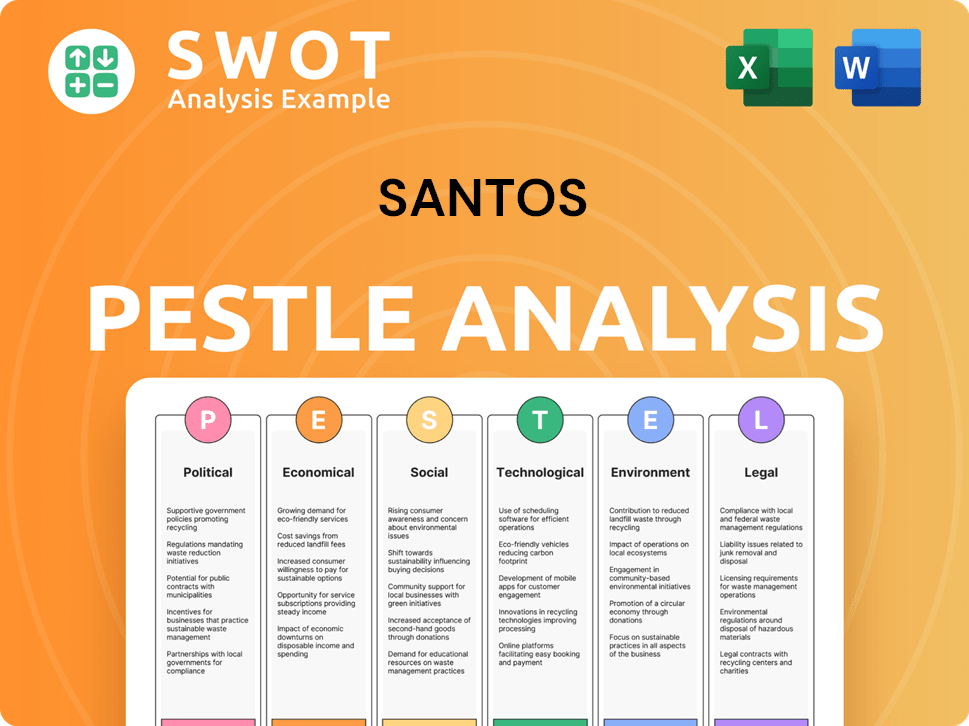
Which Strategic Decisions Have Shaped Santos’s Business Model?
The evolution of the Santos Company is marked by significant milestones, strategic shifts, and the cultivation of a competitive edge in the energy sector. The company's journey involves navigating operational challenges while capitalizing on opportunities for growth and sustainability. This includes a focus on major projects and adapting to the changing dynamics of the energy market.
Key to understanding the Santos business model is recognizing its commitment to strategic investments and operational efficiency. The company's actions are geared towards enhancing production capacity, reducing costs, and strengthening its financial position. Moreover, Santos operations are increasingly shaped by environmental considerations and a move towards decarbonization.
The company's approach involves a blend of project execution, asset management, and market positioning. This comprehensive strategy reflects its ambition to maintain a leading position in the energy industry.
A major achievement in 2024 was the launch of the Moomba Carbon Capture and Storage (CCS) project in September. This project has already sequestered over 600,000 tonnes of CO2. The company plans to expand its CCS capabilities, including the development of Darwin and WA CCS hubs.
Significant investments in major development projects are underway. The Barossa LNG project was 95.2% complete as of Q1 2025, with first gas expected in Q3 2025. The Pikka phase one project in Alaska was 74% complete by the end of 2024, with first oil targeted for mid-2026.
Legal disputes related to the Barossa gas project's environmental impact led to delays. However, the company received approval for a revised drilling plan in December 2023, allowing the project to move forward. These challenges highlight the complexities of project execution.
The company's competitive advantages include a disciplined low-cost operating model. It has a diversified portfolio of natural gas, oil, and strategic infrastructure assets. Its proximity to Asian markets provides a shipping cost and emissions advantage.
The company is focusing on decarbonizing its operations and building a commercial carbon management services business. This includes the development of CCS hubs and exploring opportunities in the hydrogen market. The company aims to increase production by over 30% by 2027 compared to 2024.
- The Moomba CCS project is designed to sequester 1.7 million tonnes of CO2 per annum.
- The sale of a 2.6% interest in PNG LNG brought in a total cash consideration of US$602 million in November 2024.
- The company's strong balance sheet and investment-grade credit rating support its strategic initiatives.
- The company's focus on the Asian market provides a strategic advantage in terms of demand and logistics.
Santos Business Model Canvas
- Complete 9-Block Business Model Canvas
- Effortlessly Communicate Your Business Strategy
- Investor-Ready BMC Format
- 100% Editable and Customizable
- Clear and Structured Layout
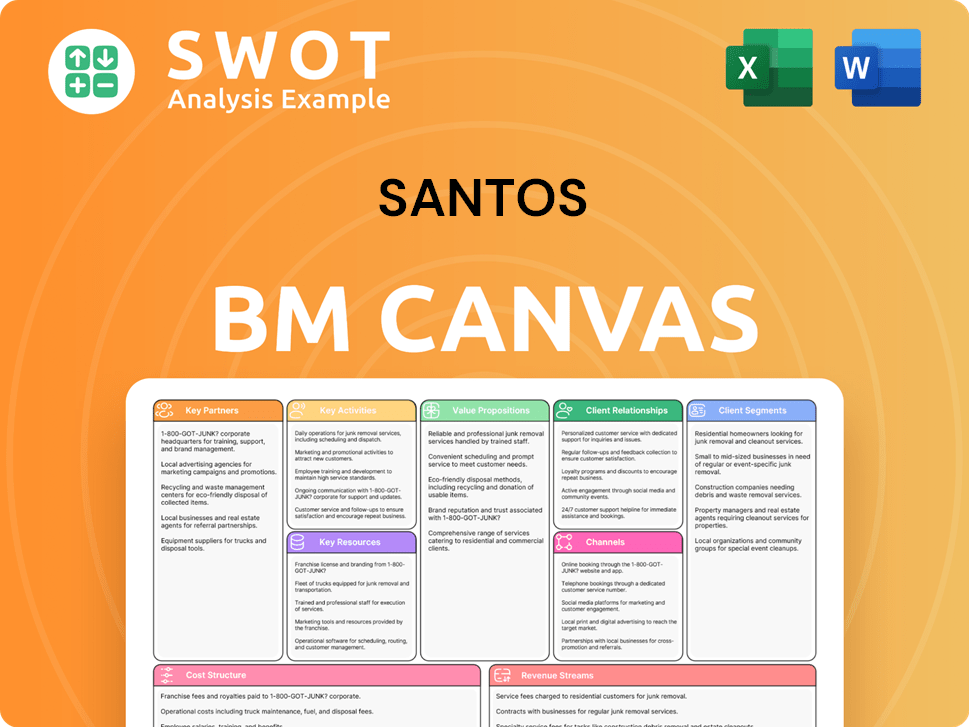
How Is Santos Positioning Itself for Continued Success?
The Santos Company holds a significant position in the Australian and Asia-Pacific energy markets. It is a leading supplier of natural gas, with a strategic aim to become a world-leading clean fuels company. The company's operations are focused on natural gas and oil exploration and production, with a growing emphasis on decarbonization initiatives. Santos's business model is centered on long-life, low-cost assets, with major projects contributing to its production capacity.
Key risks for Santos include volatile commodity prices and geopolitical uncertainties. The company's exposure to Papua New Guinea also presents challenges. However, Santos is actively pursuing strategic initiatives to mitigate these risks and capitalize on opportunities in the evolving energy landscape. These initiatives include the Climate Transition Action Plan (CTAP) and innovation roadmaps focused on low-carbon fuels.
Santos is a major player in the Australian energy sector. Its primary focus is on natural gas, with significant operations in the Asia-Pacific region. The company aims to increase production by over 30% by 2027 compared to 2024, supported by projects like Barossa and Pikka.
The company faces risks from fluctuating commodity prices and geopolitical instability. Exposure to Papua New Guinea also poses challenges. Regulatory changes and the energy transition require ongoing adaptation. These factors can influence the Santos Company share price.
Santos anticipates sustained growth in production and cash flow. Major projects and decarbonization initiatives will drive this growth. The company is focused on expanding carbon storage projects and achieving climate targets.
Santos's production for the full year 2024 was 87.1 million barrels of oil equivalent (mmboe). Sales volumes reached 91.7 mmboe. The company has achieved 84% progress towards its 2030 emissions reduction target.
Santos is actively implementing its Climate Transition Action Plan (CTAP) for 2024. The company is expanding carbon storage projects as part of its sustainability initiatives. Innovation roadmaps are focused on low-carbon fuels and carbon management services.
- Focus on safety and project delivery.
- Decarbonizing operations.
- Becoming a leaner and more efficient organization.
- Developing Darwin and WA CCS hubs.
Santos Porter's Five Forces Analysis
- Covers All 5 Competitive Forces in Detail
- Structured for Consultants, Students, and Founders
- 100% Editable in Microsoft Word & Excel
- Instant Digital Download – Use Immediately
- Compatible with Mac & PC – Fully Unlocked
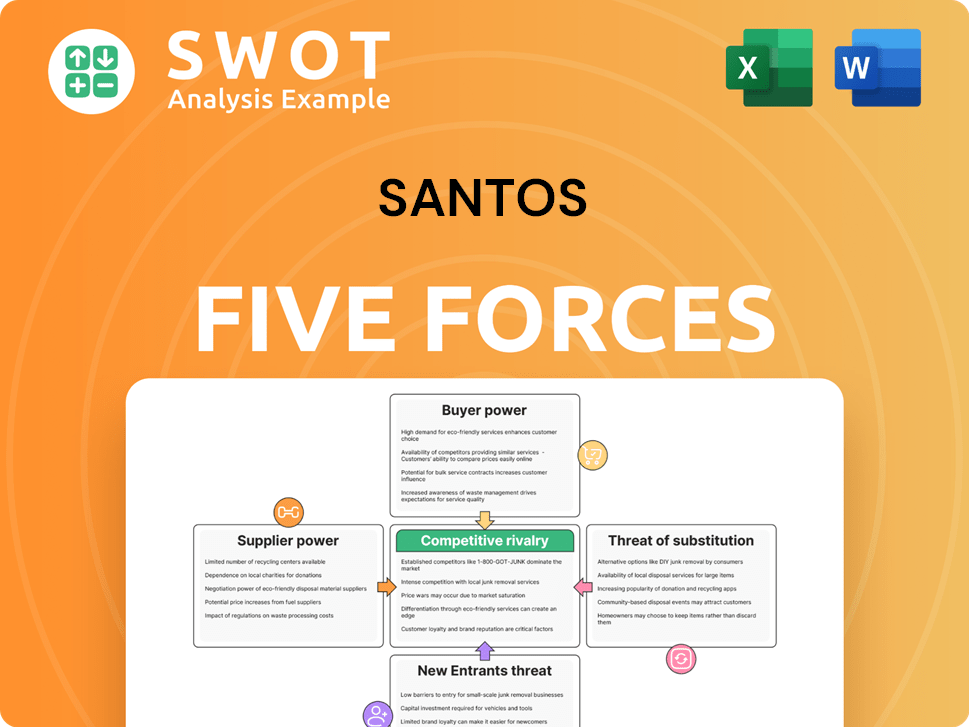
Related Blogs
- What are Mission Vision & Core Values of Santos Company?
- What is Competitive Landscape of Santos Company?
- What is Growth Strategy and Future Prospects of Santos Company?
- What is Sales and Marketing Strategy of Santos Company?
- What is Brief History of Santos Company?
- Who Owns Santos Company?
- What is Customer Demographics and Target Market of Santos Company?
Disclaimer
All information, articles, and product details provided on this website are for general informational and educational purposes only. We do not claim any ownership over, nor do we intend to infringe upon, any trademarks, copyrights, logos, brand names, or other intellectual property mentioned or depicted on this site. Such intellectual property remains the property of its respective owners, and any references here are made solely for identification or informational purposes, without implying any affiliation, endorsement, or partnership.
We make no representations or warranties, express or implied, regarding the accuracy, completeness, or suitability of any content or products presented. Nothing on this website should be construed as legal, tax, investment, financial, medical, or other professional advice. In addition, no part of this site—including articles or product references—constitutes a solicitation, recommendation, endorsement, advertisement, or offer to buy or sell any securities, franchises, or other financial instruments, particularly in jurisdictions where such activity would be unlawful.
All content is of a general nature and may not address the specific circumstances of any individual or entity. It is not a substitute for professional advice or services. Any actions you take based on the information provided here are strictly at your own risk. You accept full responsibility for any decisions or outcomes arising from your use of this website and agree to release us from any liability in connection with your use of, or reliance upon, the content or products found herein.